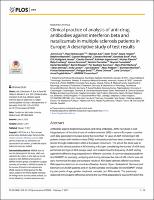| dc.contributor | Vall d'Hebron Barcelona Hospital Campus |
| dc.contributor.author | Link, Jenny |
| dc.contributor.author | Ramanujam, Ryan |
| dc.contributor.author | Auer, Michael |
| dc.contributor.author | Ryner, Malin |
| dc.contributor.author | Hassler, Signe |
| dc.contributor.author | Bachelet, Delphine |
| dc.contributor.author | Montalban Gairín, Xavier |
| dc.contributor.author | Comabella Lopez, Manuel |
| dc.contributor.author | Fissolo, Nicolás Miguel |
| dc.date.accessioned | 2019-03-22T07:20:48Z |
| dc.date.available | 2019-03-22T07:20:48Z |
| dc.date.issued | 2017-02-07 |
| dc.identifier.citation | Link J, Ramanujam R, Auer M, Ryner M, Hässler S, Bachelet D, et al. Clinical practice of analysis of anti-drug antibodies against interferon beta and natalizumab in multiple sclerosis patients in Europe: A descriptive study of test results. PLoS One. 2017;12(2):e0170395. |
| dc.identifier.issn | 1932-6203 |
| dc.identifier.uri | https://hdl.handle.net/11351/3857 |
| dc.description | Anticossos; Interferó beta; Esclerosi múltiple |
| dc.language.iso | eng |
| dc.publisher | Public Library of Science |
| dc.relation.ispartofseries | PLoS ONE;12(2) |
| dc.rights | Attribution-NonCommercial-NoDerivatives 4.0 International |
| dc.rights.uri | http://creativecommons.org/licenses/by-nc-nd/4.0/ |
| dc.source | Scientia |
| dc.subject | Esclerosi múltiple |
| dc.subject | Interferó - Immunologia |
| dc.subject | Antígens - Immunologia |
| dc.subject.mesh | Multiple Sclerosis |
| dc.subject.mesh | Interferon-beta |
| dc.subject.mesh | Natalizumab |
| dc.subject.mesh | Antibodies |
| dc.subject.mesh | /immunology |
| dc.subject.mesh | Europe |
| dc.title | Clinical practice of analysis of anti-drug antibodies against interferon beta and natalizumab in multiple sclerosis patients in Europe: A descriptive study of test results |
| dc.type | info:eu-repo/semantics/article |
| dc.identifier.doi | 10.1371/journal.pone.0170395 |
| dc.subject.decs | esclerosis múltiple |
| dc.subject.decs | interferón beta |
| dc.subject.decs | natalizumab |
| dc.subject.decs | anticuerpos |
| dc.subject.decs | /inmunología |
| dc.subject.decs | Europa (continente) |
| dc.relation.publishversion | https://journals.plos.org/plosone/article?id=10.1371/journal.pone.0170395 |
| dc.type.version | info:eu-repo/semantics/publishedVersion |
| dc.audience | Professionals |
| dc.contributor.organismes | Institut Català de la Salut |
| dc.contributor.authoraffiliation | [Link J] Department of Clinical Neuroscience, Karolinska Institutet, Stockholm, Sweden. [Ramanujam R] Department of Clinical Neuroscience, Karolinska Institutet, Stockholm, Sweden. KTH - Royal Institute of Technology, Stockholm, Sweden. [Auer M] Innsbruck Medical University, Innsbruck, Austria. [Ryner M] Department of Clinical Neuroscience, Karolinska Institutet, Stockholm, Sweden. [Hässler S, Bachelet D] CESP, Université Paris-Sud, UVSQ, INSERM, Université Paris-Saclay, Villejuif, France. [Fissolo N, Comabella M, Montalban X] Centre d'Esclerosi Múltiple de Catalunya, Barcelona, Spain. Hospital Universitari Vall d'Hebron, Barcelona, Spain. |
| dc.identifier.pmid | 28170401 |
| dc.identifier.wos | WOS:000393705500005 |
| dc.rights.accessrights | info:eu-repo/semantics/openAccess |

